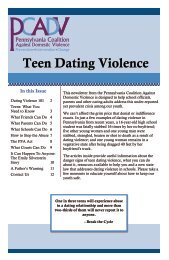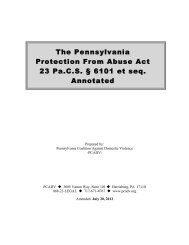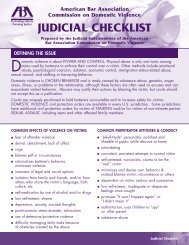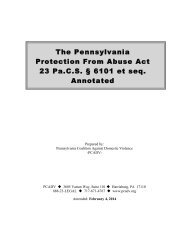Toolkit with Report Form - Pennsylvania Coalition Against Domestic ...
Toolkit with Report Form - Pennsylvania Coalition Against Domestic ...
Toolkit with Report Form - Pennsylvania Coalition Against Domestic ...
Create successful ePaper yourself
Turn your PDF publications into a flip-book with our unique Google optimized e-Paper software.
Section five<br />
Communication <strong>with</strong> Family Members<br />
During and immediately after a crisis, staff,<br />
volunteers and clients are likely to have a<br />
very real need to communicate and connect<br />
<strong>with</strong> their families as soon as possible. This<br />
has very practical implications, but even<br />
more, feeds their need to establish a sense of<br />
safety and security for their loved ones. In the<br />
development of a Critical Incident Response<br />
Plan, determine a safe way for your staff to<br />
contact family members to inform them they<br />
are OK. It is important to maintain control<br />
over how much information is shared – even<br />
<strong>with</strong> family.<br />
Documentation After an Incident<br />
All staff, volunteers and BOD who were<br />
directly involved in the incident should<br />
prepare a written account of their<br />
involvement as soon as possible and provide<br />
it to the team in charge. In the event law<br />
enforcement or other authorities request<br />
these documents, confidentiality provisions<br />
continue to apply. (Refer to your program’s<br />
confidentiality policy and Protecting<br />
Confidentiality in Section 4: Support from<br />
PCADV Legal Department for more complete<br />
information).<br />
Crisis Intervention<br />
It is important to balance the need to “get<br />
back to business as usual” <strong>with</strong> the need<br />
to address the emotional state of staff,<br />
residents, clients and volunteers who have<br />
been impacted by the incident. PCADV<br />
does not provide direct crisis response or<br />
critical incident debriefing, but does provide<br />
technical assistance and referrals to others<br />
who have expertise in providing direct<br />
services to communities in crisis (See page 2<br />
for details).<br />
Sources of Technical Assistance<br />
◗ There are many crisis response groups/<br />
agencies across the Commonwealth.<br />
All of the statewide agencies and<br />
organizations that are part of the<br />
<strong>Pennsylvania</strong> Emergency Management<br />
Response Plan have specified roles for<br />
national or statewide disaster/crisis<br />
response. Many counties have local<br />
crisis response teams that can provide<br />
community assistance in the aftermath of<br />
a natural disaster.<br />
◗ Some critical incident response<br />
agencies/organizations focus on a<br />
specific population involved in a critical<br />
incident.<br />
◗ Critical Incident Stress Management<br />
Teams respond to the needs of first<br />
responders.<br />
◗ School districts and intermediate units<br />
have specially trained staff to respond to<br />
school communities.<br />
“Simple techniques for intervening in<br />
crisis can help survivors regain a sense<br />
of control over their lives and begin<br />
the process of reconstructing a new<br />
life. Much of the crisis intervention rests<br />
[<strong>with</strong>] creative listening and helping<br />
people develop ideas for how they<br />
will cope <strong>with</strong> the next few hours or<br />
days of their life in the aftermath of a<br />
traumatic event.”<br />
~ National Organization For<br />
Victim Assistance (NOVA),<br />
The Community Crisis Response<br />
Team Training Manual<br />
page 22<br />
When Crisis Strikes | <strong>Pennsylvania</strong> <strong>Coalition</strong> <strong>Against</strong> <strong>Domestic</strong> Violence | 2012








